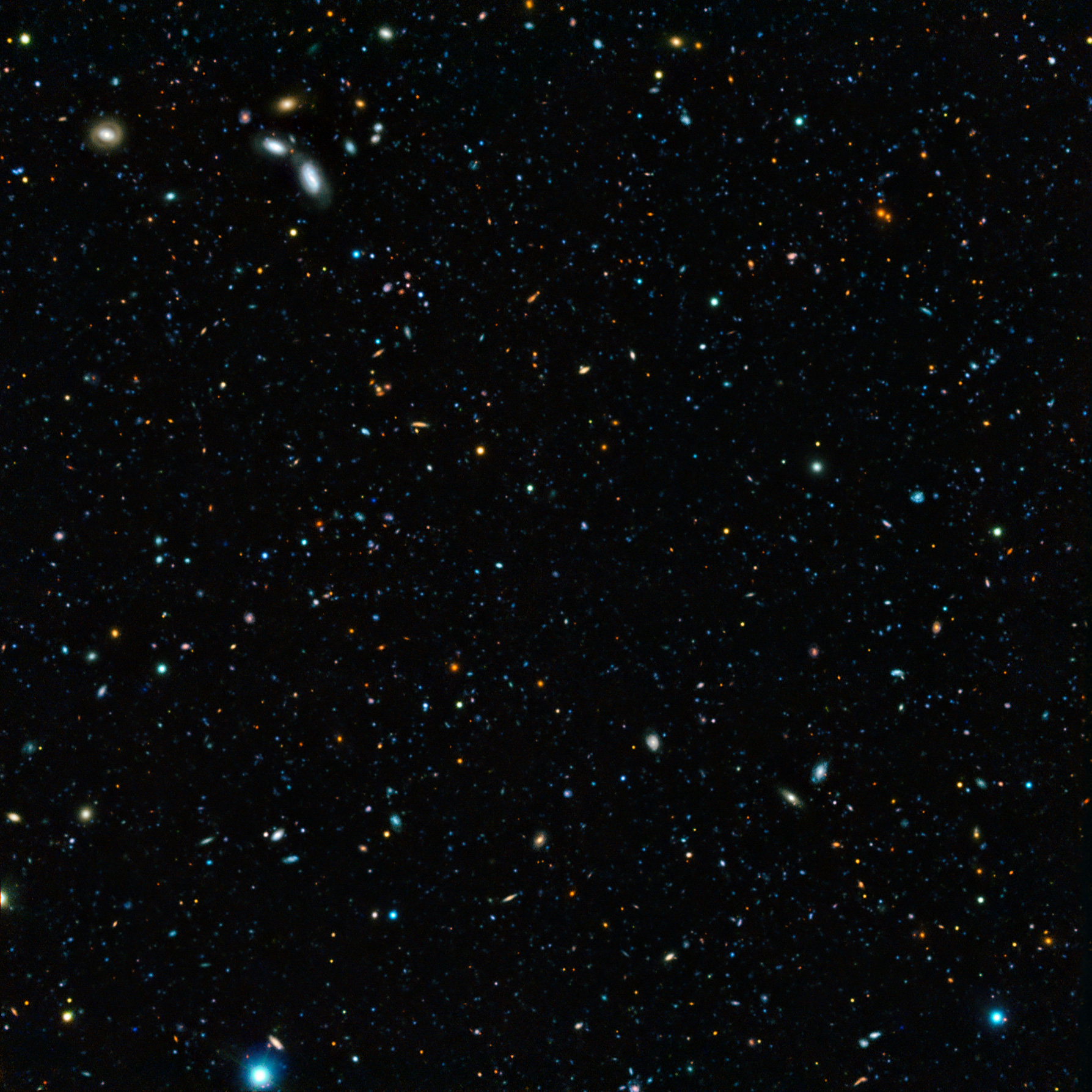|
EROSITA
eROSITA is an X-ray instrument built by the Max Planck Institute for Extraterrestrial Physics (MPE) in Germany. It is part of the Russian–German Spektr-RG space observatory, which also carries the Russian telescope ART-XC. It was launched by Roscosmos on 13 July 2019 from Baikonur, and deployed in a 6-month halo orbit around the second Lagrange point (L2). It began collecting data in October 2019. Due to the breakdown of institutional cooperation between Germany and Russia after the invasion of Ukraine, the instrument stopped collecting data on February 26, 2022. Overview eROSITA was originally designed by the ESA for the International Space Station, and it was concluded in 2005 that its accommodation on a dedicated free flyer would provide significantly improved scientific output. The eROSITA telescopes are based on the design of the ABRIXAS observatory launched in April 1999, whose battery was accidentally overcharged and destroyed three days after the mission started. ... [...More Info...] [...Related Items...] OR: [Wikipedia] [Google] [Baidu] |
Spektr-RG
Spektr-RG (Russian: Спектр-РГ, ''Spectrum'' + '' Röntgen'' + '' Gamma''; also called Spectrum-X-Gamma, SRG, SXG) is a Russian–German high-energy astrophysics space observatory which was launched on 13 July 2019. It follows on from the Spektr-R satellite telescope launched in 2011. Background The original idea for this X-ray observatory satellite orbiting above Earth's atmosphere, which filters X-rays, was first proposed in the 1980s by Rashid Sunyaev of the Space Research Institute of the USSR Academy of Sciences. Twenty institutions from twelve countries came together to design a large observatory with five telescopes. However, after the collapse of the Soviet Union, the mission was abandoned due to cost-cutting from the Russian space program Roscosmos. The project was resurrected in 2003 with a scaled-down design. Overview The primary instrument of the mission is eROSITA, built by the Max Planck Institute for Extraterrestrial Physics (MPE) in Germany. It is ... [...More Info...] [...Related Items...] OR: [Wikipedia] [Google] [Baidu] |
Astronomical Roentgen Telescope -- X-ray Concentrator
The Astronomical Roentgen Telescope X-ray Concentrator (ART-XC) is an X-ray telescope with a grazing incidence mirror that is capable of capturing high energy X-ray photons within the 5-30 keV energy range. This telescope is one of the two X-ray telescopes on the Spektr-RG (SRG) mission. The other telescope that SRG carries is eROSITA. The observatory was launched on 13 July 2019 via a Proton rocket from the Russian launch site Baikonur in Kazakhstan. Overview ART-XC was developed by the Space Research Institute (IKI) and the All-Russian Scientific Research Institute for Experimental Physics (VNIIEF). The NASA Marshall Space Flight Center (MSFC) has developed and fabricated flight models of the X-ray mirror systems. The ART-XC telescope consists of 7 identical mirror modules each made with 28 nickel-cobalt grazing-incidence mirrors. The mirror design is Wolter-I and is coated with iridium. Each module also has its own cadmium-tellurium double-sided strip detector. The typical on ... [...More Info...] [...Related Items...] OR: [Wikipedia] [Google] [Baidu] |
Max Planck Institute For Extraterrestrial Physics
The Max Planck Institute for Extraterrestrial Physics is a Max Planck Institute, located in Garching, near Munich, Germany. In 1991 the Max Planck Institute for Physics and Astrophysics split up into the Max Planck Institute for Extraterrestrial Physics, the Max Planck Institute for Physics and the Max Planck Institute for Astrophysics. The Max Planck Institute for Extraterrestrial Physics was founded as sub-institute in 1963. The scientific activities of the institute are mostly devoted to astrophysics with telescopes orbiting in space. A large amount of the resources are spent for studying black holes in the galaxy and in the remote universe. History The Max-Planck-Institute for extraterrestrial physics (MPE) was preceded by the department for extraterrestrial physics in the Max-Planck-Institute for physics and astrophysics. This department was established by Professor Reimar Lüst on October 23, 1961. A Max-Planck Senate resolution transformed this department into a sub-inst ... [...More Info...] [...Related Items...] OR: [Wikipedia] [Google] [Baidu] |
ABRIXAS
A Broadband Imaging X-ray All-sky Survey, or ABRIXAS was a space-based German X-ray telescope. It was launched on 28 April 1999 in a Kosmos-3M launch vehicle from Kapustin Yar, Russia, into Earth orbit. The orbit had a periapsis of , an apoapsis of , an inclination of 48.0° and an eccentricity of 0.00352, giving it a period of 96 minutes. The telescope's battery was accidentally overcharged and destroyed three days after the mission started. When attempts to communicate with the satellite — while its solar panels were illuminated by sunlight — failed, the $20 million project was abandoned. ABRIXAS decayed from orbit on 31 October 2017. The eROSITA telescope is based on the design of the ABRIXAS observatory. eROSITA was launched on board the Spektr-RG space observatory on 13 July 2019 from Baikonur to be deployed at the second Lagrange point (L2). See also * German space programme The German space programme is the set of projects funded by the government of Germany ... [...More Info...] [...Related Items...] OR: [Wikipedia] [Google] [Baidu] |
Wolter Telescope
A Wolter telescope is a telescope for X-rays that only uses grazing incidence optics – mirrors that reflect X-rays at very shallow angles. Problems with conventional telescope designs Conventional telescope designs require reflection or refraction in a manner that does not work well for X-rays. Visible light optical systems use either lenses or mirrors aligned for nearly normal incidence – that is, the light waves travel nearly perpendicular to the reflecting or refracting surface. Conventional mirror telescopes work poorly with X-rays, since X-rays that strike mirror surfaces nearly perpendicularly are either transmitted or absorbed – not reflected. Lenses for visible light are made of transparent materials with an index of refraction substantially different from 1, but all known X-ray-transparent materials have index of refraction essentially the same as 1, so X-ray lenses are not practical. X-ray mirror telescope design X-ray mirrors can be built, but only if the angle f ... [...More Info...] [...Related Items...] OR: [Wikipedia] [Google] [Baidu] |
ROSAT
ROSAT (short for Röntgensatellit; in German X-rays are called Röntgenstrahlen, in honour of Wilhelm Röntgen) was a German Aerospace Center-led satellite X-ray telescope, with instruments built by West Germany, the United Kingdom and the United States. It was launched on 1 June 1990, on a Delta II rocket from Cape Canaveral, on what was initially designed as an 18-month mission, with provision for up to five years of operation. ROSAT operated for over eight years, finally shutting down on 12 February 1999. In February 2011, it was reported that the satellite was unlikely to burn up entirely while re-entering the Earth's atmosphere due to the large amount of ceramics and glass used in construction. Parts as heavy as could impact the surface. ROSAT eventually re-entry, re-entered the Earth's atmosphere on 23 October 2011 over Bay of Bengal. Overview According to NASA, the Roentgensatellit (ROSAT) was a joint German, U.S. and British X-ray astrophysics project. ROSAT carrie ... [...More Info...] [...Related Items...] OR: [Wikipedia] [Google] [Baidu] |
Galaxy Clusters
A galaxy cluster, or a cluster of galaxies, is a structure that consists of anywhere from hundreds to thousands of galaxies that are bound together by gravity, with typical masses ranging from 1014 to 1015 solar masses. They are the second-largest known gravitationally bound structures in the universe after galaxy filaments and were believed to be the largest known structures in the universe until the 1980s, when superclusters were discovered. One of the key features of clusters is the intracluster medium (ICM). The ICM consists of heated gas between the galaxies and has a peak temperature between 2–15 keV that is dependent on the total mass of the cluster. Galaxy clusters should not be confused with ''galactic clusters'' (also known as open clusters), which are star clusters ''within'' galaxies, or with globular clusters, which typically orbit galaxies. Small aggregates of galaxies are referred to as galaxy groups rather than clusters of galaxies. The galaxy groups an ... [...More Info...] [...Related Items...] OR: [Wikipedia] [Google] [Baidu] |
Astronomical Survey
An astronomical survey is a general map or image of a region of the sky (or of the whole sky) that lacks a specific observational target. Alternatively, an astronomical survey may comprise a set of images, spectra, or other observations of objects that share a common type or feature. Surveys are often restricted to one band of the electromagnetic spectrum due to instrumental limitations, although multiwavelength surveys can be made by using multiple detectors, each sensitive to a different bandwidth. Surveys have generally been performed as part of the production of an astronomical catalog. They may also search for transient astronomical events. They often use wide-field astrographs. Scientific value Sky surveys, unlike targeted observation of a specific object, allow astronomers to catalog celestial objects and perform statistical analyses on them without complex corrections for selection effects. In some cases, an astronomer interested in a particular object will find t ... [...More Info...] [...Related Items...] OR: [Wikipedia] [Google] [Baidu] |
Dark Energy
In physical cosmology and astronomy, dark energy is an unknown form of energy that affects the universe on the largest scales. The first observational evidence for its existence came from measurements of supernovas, which showed that the universe does not expand at a constant rate; rather, the universe's expansion is accelerating. Understanding the universe's evolution requires knowledge of its starting conditions and composition. Before these observations, scientists thought that all forms of matter and energy in the universe would only cause the expansion to slow down over time. Measurements of the cosmic microwave background (CMB) suggest the universe began in a hot Big Bang, from which general relativity explains its evolution and the subsequent large-scale motion. Without introducing a new form of energy, there was no way to explain how scientists could measure an accelerating universe. Since the 1990s, dark energy has been the most accepted premise to account for the acce ... [...More Info...] [...Related Items...] OR: [Wikipedia] [Google] [Baidu] |
Active Galactic Nuclei
An active galactic nucleus (AGN) is a compact region at the center of a galaxy that has a much-higher-than-normal luminosity over at least some portion of the electromagnetic spectrum with characteristics indicating that the luminosity is not produced by stars. Such excess non-stellar emission has been observed in the radio, microwave, infrared, optical, ultra-violet, X-ray and gamma ray wavebands. A galaxy hosting an AGN is called an "active galaxy". The non-stellar radiation from an AGN is theorized to result from the accretion of matter by a supermassive black hole at the center of its host galaxy. Active galactic nuclei are the most luminous persistent sources of electromagnetic radiation in the universe, and as such can be used as a means of discovering distant objects; their evolution as a function of cosmic time also puts constraints on models of the cosmos. The observed characteristics of an AGN depend on several properties such as the mass of the central black hole, th ... [...More Info...] [...Related Items...] OR: [Wikipedia] [Google] [Baidu] |







